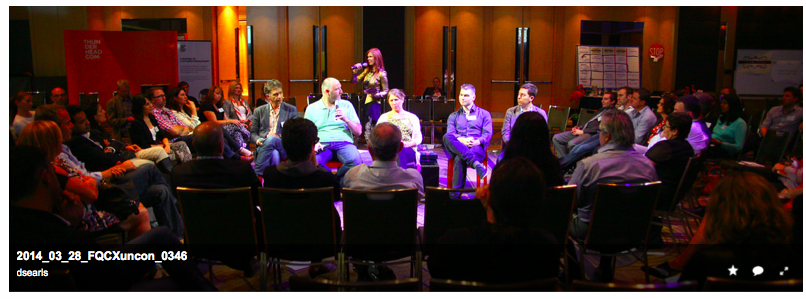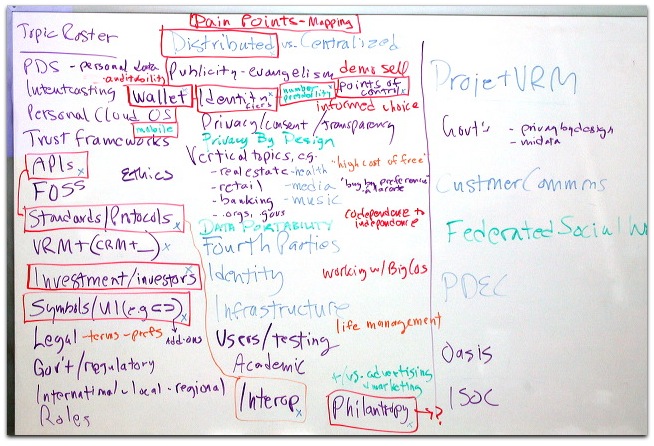It’s as simple as that.
Identity is not corporate. That means no company is going to “win” at personal identity, any more than any company can win at being you or me. It makes no sense.
But meanwhile, there’s this big war going on over identity, that Mike Elgan of CultOfMac covers (from the Apple side) in Why the ‘i’ in iPhone Will Stand For ‘Identity’. Writes Mike,
Google honcho Eric Schmidt came right out and said it: “Google+ was created primarily as an identity service.”
And Om Malik nailed it when he said: “The real power of Facebook lies in controlling connected identity.”
Both Google and Facebook made big pushes to turn their social networks into solid identity services. And both those attempts have largely failed so far.
But Apple can win, Mike says. Here’s why:
I think Apple can succeed where the social networks failed.
The reason is that Apple has a better deal for users. The social network proposed both a small stick and a small carrot: Use one account and use your real name because then everything is better. That approach failed.
Apple’s proposition is much better: Use the Identity iPhone, and stop keying in passwords, credit card numbers, billing information and more. As you cruise through the Internet, all the doors will open for you and you can securely use and buy and access anything you want without any work.
How Apple Will Use the Identity iPhone
Once you’ve associated your actual fingerprint with your iPhone, your iPhone becomes you — better than a photo ID, better than a signature, better than a password.
Today, a swipe of the finger on an iPhone conjures up the 4-digit passcode lock. If you spend some quality time with the Passcode Lock page in Settings, you can see that you have an option to turn it on or off, require it immediately or after one, five or fifteen minutes or after one or four hours. It also allows you to access or not access Passbook and the ability to reply to a message when the phone is locked.
All those settings may be identical to the fingerprint scanning feature of the next iPhone….
I believe Apple intends to build both NFC and fingerprint readers into iMacs and iPads.
When you set your iPhone next to the keyboard of your iMac, all your online activity will identity you to various sites, which means that you’ll have an “E-Z Pass” right through password dialogs and credit card pages. You’ll just be able to log in as you and buy stuff without typing anything…
In the Real World, you’ll be able to authenticate purchases either via Bluetooth or NFC, skipping the line at the movie theater, department store and gas station. You’ll be billed, and be able to pay for your restaurant meal without the waiter’s involvement. (Letting a stranger take your credit card out of your sight is one of the weakest links in the way commerce works right now.)
As I wrote in Identity systems, failing to communicate,
What’s fucked up about identity is that every site and service has its own identity system. None are yours. All are theirs, all are silo’d, and all are different. For this we can thank the calf-cow model of client-server computing, and we are stuck in it. That’s why we are forced to remember how we identify ourselves, separately, as calves, to many different cows, each of which act like they’re the only damn cow in the world.
And I gotta say, Apple sucks at being an identity cow. I am three different calves to Apple right now. That is, three different AppleIDs. I have spoken to Apple people many times about their need to merge customer namespaces, and they give me the same answer every time: it’s too hard. Worse, they’ve screwed it up over and over. An Apple mail account that was once foo@mac.com then became foo@me.com is now also foo@icloud.com. On that basis alone Apple amply demonstrates the namespace problem, which might be the oldest problem (that’s still with us) in all of computing.
Einstein said, No problem can be solved from the same level of consciousness that created it. The namespace problem was created — and worsened — by companies creating more namespaces. One more bigfoot creating one more way to leverage its own private namespace to the whole world is not a solution. It’s one more problem to solve.
The only way to solve the identity problem is where the most pain is felt: at the individual level.
This is a very hard fact for enterprise-level solution-makers to grok, because at their level the solution is always yet another namespace or yet another bigfoot company pushing yet another technical solution. That, in effect, is what Mike says Apple will do here. And they will fail, just like Facebook, Google, Microsoft (remember Hailstorm and Passport?) and every other bigfoot has failed. Because they can’t solve it.
Meanwhile, we’ve solved this kind of thing before at the personal level, over and over, and we will do it again.
If you want to help work on it, come to the Internet Identity Workshop next week in Mountain View. That’s where the real work is happening.

 Youstice
Youstice
 Google on Friday announced that it would soon be able to show users’ names, photos, ratings and comments in ads across the Web, endorsing marketers’ products. Facebook already runs similar endorsement ads. But on Thursday it, too, took a step to show personal information more broadly by changing its search settings to make it harder for users to hide from other people trying to find them on the social network.
Google on Friday announced that it would soon be able to show users’ names, photos, ratings and comments in ads across the Web, endorsing marketers’ products. Facebook already runs similar endorsement ads. But on Thursday it, too, took a step to show personal information more broadly by changing its search settings to make it harder for users to hide from other people trying to find them on the social network. We’re
We’re


